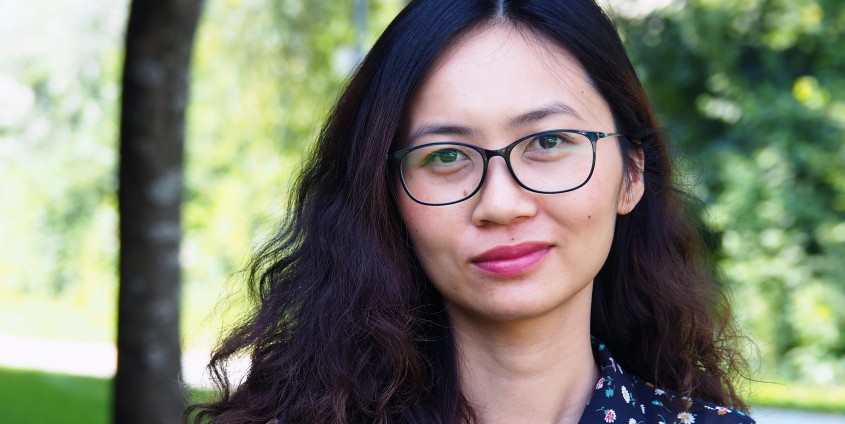Mathematics supports new medical imaging techniques
While MRI, CT and x-ray already provide valuable insights into the interior of the body, the technology involving so-called magnetic particle imaging now promises new possibilities with high resolution, less acquisition time and no harmful radiation. In order to be able to draw conclusions about biological processes based on the observation of magnetic particles in a magnetic field, research has to rely on mathematics. Tram Thi Ngoc Nguyen is completing her doctoral thesis on this topic at the University of Klagenfurt.
“Those who are willing to work hard and have the patience to allow the field of mathematics to open up to them, are rewarded in the end: They gain profound knowledge of the beauty of this discipline”, Tram Thi Ngoc Nguyen tells us. She came to the University of Klagenfurt from Vietnam in order to pursue her doctoral studies here. Before this, she spent eight years working as a geophysicist in the industrial sector. She regards Klagenfurt as a location that is ideally suited to conducting research: “The city is very peaceful and surrounded by mountains and the lake, which offer a stunning backdrop. There is also less distraction here than elsewhere.” Asked to explain what defines the aesthetics of mathematics, she offers her thoughts on the matter: “One endeavours to get to the bottom of things, and is faced with clear proofs, which remove all ambiguity. For me, this clarity is beautiful.” When she first started her studies, she was primarily interested in chemistry and computer science. It took a while before she found her way into this special discipline. Nonetheless, she enthusiastically encourages others to take this course, and adds: “Even if you believe that mathematics lies above your own intellectual capabilities: It is absolutely worthwhile to put in the effort. I still find mathematics quite demanding, even today, but I also find it very enjoyable.”
In line with this approach, she is currently working on her doctoral thesis with great intensity, with the aim of making a contribution to new medical imaging techniques. The so-called magnetic particle imaging (MPI), which will be deployed in future alongside other procedures such as CT, MRI or x-ray, looks set to offer new possibilities. MPI is a dynamic imaging modality for medical applications that has been recently introduced in 2005 by B. Gleich and J. Weizenecker. The technique involves introducing magnetic nanoparticles into the bloodstream of a patient and generating an image of particle concentration. This procedure is expected to permit very high resolution (less than 1 micrometre, which is better than MRI) and greater speed (just 0.1 second for acquisition time, also faster than MRI) when it comes to visualising the human blood flow. All that acts on the body from the outside is an oscillating magnetic field. The nanoparticles in the body subsequently behave according to the magnetic field causing the change in the particle magnetization, thus induces an electric current in a coil. By measuring the induced voltage in multiple receive coils, it is possible to draw conclusions about the spatial concentration of the particles inside the body. Since the particles are distributed along the bloodstream of a patient, the particle concentration yields information on the blood flow.
Mathematics supports this process with the help of so-called “inverse problems”. These are used to trace the effect of a system (the measured voltage in the receive coils) back to an underlying cause (the particle concentration). The theoretical part of Tram Thi Ngoc Nguyen’s work is largely completed. What follows now is a series of experiments, which will mostly be conducted at a computer for the mathematical aspects. In the long term, Tram Thi Ngoc Nguyen hopes to remain in the world of academia once she has completed her doctoral studies, “as this offers great freedom to follow one’s individual interests.” Plenty of interesting questions remain, she believes, particularly in the case of inverse problems, which are extremely challenging or even unsolvable from today’s point of view.
A few words with … Tram Thi Ngoc Nguyen
What would you be doing now, if you had not become a scientist?
Possibly, I would have been still working in industry, of course, in the fields where I see the presence of Math.
Do your parents understand what it is you are working on?
I would say: It is not always necessary to clearly understand something to make a great support for.
What is the first thing you do when you arrive at the office in the morning?
Scan email, take a coffee and start the work that I had scheduled before
Do you have proper holidays? Without thinking about your work?
Yes, I try to set up regular holidays to recharge my energy.
However, the unsolved math questions naturally stay in my mind, and the answers sometime appear at the most unexpected moments, for instance, when I have just waken up in the morning or while taking a shower.
What calms you down?
To see the act of kindness.
Who do you regard as the greatest scientist in history, and why?
I find Bill Gates very inspiring. I admire Gates‘s work not only because of his technological innovations but also of his charity work. I think he is one of the best life-changing philanthropists.
What are you looking forward to?
Working on the next topic.
Studying mathematics
At Universität Klagenfurt, there are several ways of studying mathematics. Our standalone degree programmes in mathematics are:
- Bachelor’s programme in Technical Mathematics or Master’s programme in Mathematics,
- Bachelor’s or Master’s programmes in teaching mathematics.
- A doctoral programme with dissertation element on technical mathematics or the didactics of mathematics











